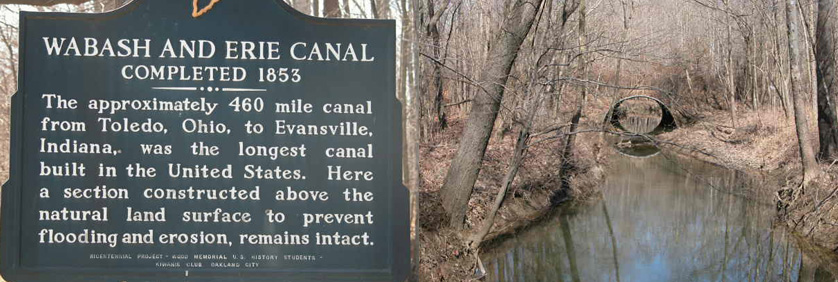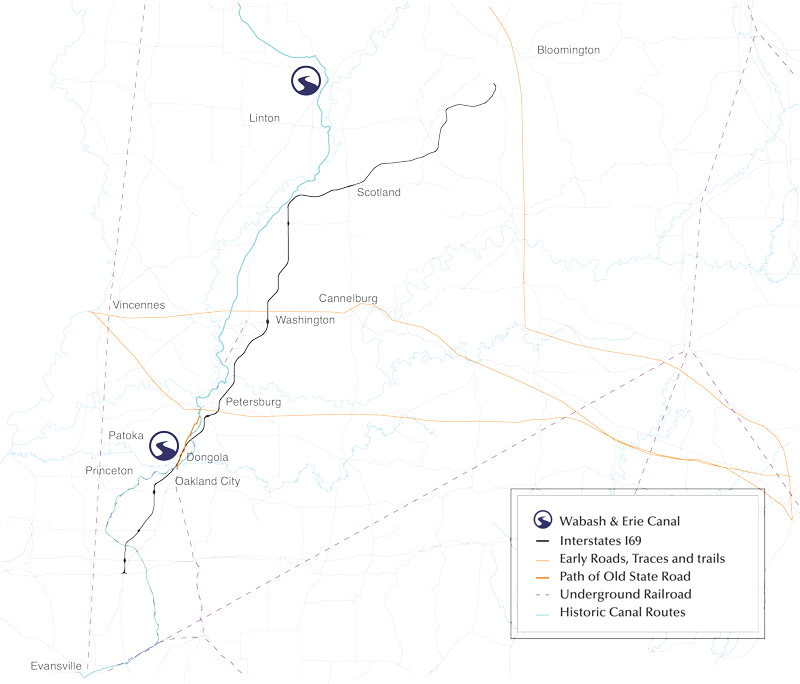I-69 crosses the route of the Wabash & Erie Canal three times, most noticeably to the east of the Patoka bridge, running along a retention pond. This audio tour presents the “Wabash & Erie Canal,” one of a series of vignettes that recounts the history of the land crossed by I-69 between I-64 and Bloomington, Indiana. Choose one or all of the vignettes to learn about the cultural and natural landscape along I-69.
Maurice Thompson provides a first person account of the Wabash and Erie Canal and a map provides locational information. The following narrative discloses the names of towns and interchanges where these historic activities have occurred along our route.
Observe the following landmarks and communities: Odon, Washington, Petersburg, Oakland City, Patoka River, and Patoka Wildlife Refuge.
“The canal boat was a long, low, narrow structure built for carrying both passengers and freight. Its cabin and sleeping berths were of the most primitive description, ill-ventilated and dimly lighted . . . It was drawn by one or two horses hitched to a long rope attached to the bow of the boat. The horses walked on a path, called the towpath, at the side of the canal, and were driven by a man or boy, who sometimes rode, sometimes walked. The boat […] crept along like a great lazy turtle on the still water. Surely there never was a sleepier mode of travel.”—Maurice Thompson, Stories of Indiana, 1898
- Read More

The Wabash and Erie Canal was completed in 1853. Portions of the 460 miles are still visible across the landscape. (Weintraut & Associates, Inc.)The Wabash & Erie Canal once stretched west from Toledo, Ohio, at Lake Erie across central Indiana and south to link with the Ohio River at Evansville. The United States Congress had allotted a large land grant in 1827 to Indiana for the purpose of building a canal to provide a transportation route for travelers and goods. Construction on the Wabash & Erie Canal began in Indiana at Fort Wayne in 1832.[1]
Unfortunately, Indiana had difficulty selling the bonds to finance the construction of the canal. A financial panic in 1837 led to uncertainty and put a damper on funding for large state projects. As a result, canal building in Indiana floundered for a number of years and progress was slow.[2]
Construction of the canal proved tedious and dangerous. In the beginning, the state contracted construction to local farmers, but eventually thousands of workers (mainly Irish or German immigrants) made their way west to provide labor.[3] Conditions were far
from ideal. Laborers dealt with long, grueling days in all types of weather, seven days a week. Illness was rampant; cholera and malaria routinely swept through the camps, killing men even as they worked.
In 1846, the federal government utilized the canal in the forcible removal of the Miami Tribe from Indiana. The removal route did not pass through the portion of the canal in southwestern Indiana, but rather ran northeast to Fort Wayne then south to Cincinnati and the Ohio River. The Miami were then placed on westbound steamships that transported them to their final destinations in the Kansas and Oklahoma territories.[4] The Cincinnati Gazette reported the removal of the Miami tribes, listing Tribe members as a shipment.
The Miamis—A portion of the remnant of the Miami Indians, alluded to in our notice of the arrival of the Chief Lafontaine reached here yesterday by the Miami Canal, and marched down Main Street, to the river, where they embarked on the steamer Colorado, for St. Louis.
Shipments. TO ST. LOUIS—By the COLORADO: 30 tons Dry Goods, 32 casks Government Stores, [350] Indians, with their Baggage.
—Cincinnati Gazette, October 13, 1846[5]
By 1850, a consortium of businessmen took ownership of the Wabash & Erie Canal. The new owners, some of whom lived in or around Petersburg, continued the canal southward until it reached Evansville in 1853. A total of 468 miles long, it was the longest canal in the nation.[6] For seven years, the entirety of the Wabash & Eric Canal operated from Toledo, Ohio, to Evansville, Indiana, although few canal boats ever traveled the entire distance.
Exiting I-69 and traveling into Petersburg, look to the south along Goodlet Street where the Goodlet Morgan House is located. Morgan, an investor in the Southern Indiana Canal Company, built the large brick Italianate house. (Note, this home is a private residence.)
In 1860, the Terre Haute-to-Evansville portion of the canal closed, and with the exception of point-to-point operations between towns, the canal ceased to exist as a link between the Great Lakes and the Ohio River. The owners of the canal officially ended operations in 1874.[7] There are some visible physical remains of the defunct canal system in southwestern Indiana. These include abutments for aqueducts, remains of locks, dilapidated sections of the canal profile, and evidence of water control structures, such as waste gates and guard locks. In some places, the towpath of the canal is still visible.
The Wabash & Erie Canal was short-lived, but it was an engineering feat unlike any other. In some places still visible on the landscape, the canal served its purpose during a time when transportation in Indiana was a work in progress. Today, as travelers drive I-69, they can imagine a time when the scenery was much different and travel was taken in at a much slower pace.
[1] Ralph D. Gray, “The Canal Era in Indiana,” Transportation and the Early Nation (Indianapolis: Indiana Historical Society, 1982), 119; Maggie Greenwood Robinson, Evansville: Crossroads of the Midwest (Montgomery, AL: Community Communications Inc., 2000), 15; Madison, Indiana Way, 82.
[2] John Warner, “The Influence of the Wabash and Erie Canal on the Development of Two Northern Indiana Communities, 1830-1860” (Indianapolis: Master’s Thesis, Indiana University, 1996), 12-15.
[3] Bennett, ed. “Canal Mania in Indiana.” Warner, “The Influence of the Wabash and Erie Canal,” 10.
[4] Miami Tribe of Oklahoma, “myaamiaki aanchisaaciki: A Cultural Exploration of the Myaamia Removal Route,” 3-7, accessed June 13, 2019, https://myaamiahistory.files.wordpress.com/2018/10/myaamia_removal.pdf.
[5] “The Miamis,” Cincinnati Gazette, (October 13, 1846), 2; “Shipments,” Cincinnati Gazette, (October 13, 1846), 3, reproduced in Myaamiaki Aancihsaaciki: A Cultural Exploration of the Myaamia Removal Route (Miami OK.: Miami Tribe of Oklahoma, 2011), 33, available at https://myaamiahistory.files.wordpress.com/2018/10/myaamia_removal.pdf.
[6] Bennett, ed. “Canal Mania in Indiana,”5.
[7] Warner, “The Influence of the Wabash and Erie Canal,”15–16.
Wabash & Erie Canal Path And Remnants

